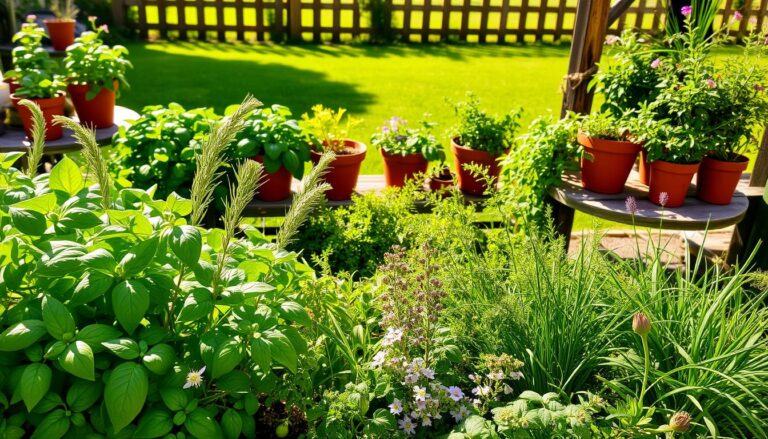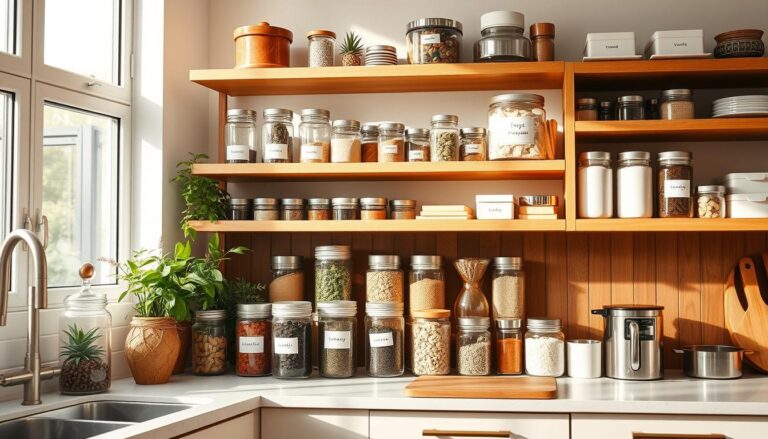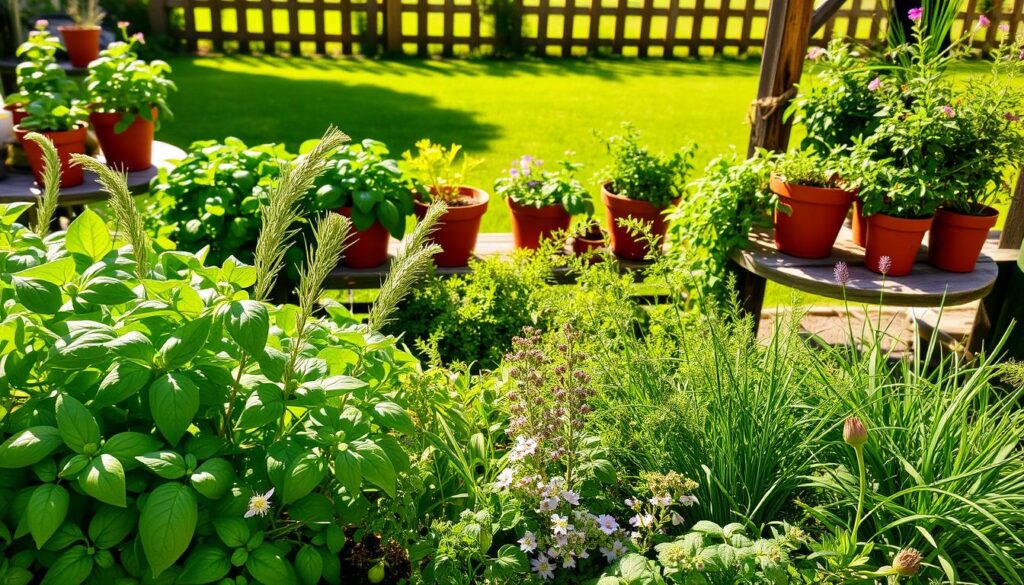
Are fresh culinary herbs the secret ingredient you’ve been missing in your recipes? Having a steady supply of fresh herbs can elevate your dishes and add depth to your cooking.
We explore the world of culinary herbs and how easy it is to grow your own herb garden. With a variety of herbs to choose from, you can add a personal touch to your cooking and experiment with different cuisines.
Growing your own herb garden not only provides you with fresh ingredients but also adds a touch of greenery to your space.
Key Takeaways
- Discover the benefits of having a fresh herb supply for cooking.
- Learn how to easily grow your own herb garden.
- Explore the variety of culinary herbs you can use in different recipes.
- Understand how growing your own herbs can enhance your cooking experience.
- Find out how to incorporate fresh herbs into your daily meals.
The Benefits of Growing Your Own Kitchen Herbs
Cultivating kitchen herbs at home offers numerous benefits that can enhance your cooking experience. By having your own herb garden, you can elevate your dishes with fresh flavors, save money, contribute to a more sustainable environment, and enjoy various health benefits.
Flavor Benefits of Fresh Herbs
Fresh herbs add a depth of flavor to dishes that dried herbs cannot match. Growing your own herbs ensures you have a constant supply of fresh flavors at your fingertips. For instance, basil adds a bright, summery flavor to pesto, while rosemary provides a piney taste to roasted meats.
Cost Savings of Home-Grown Herbs
Growing your own herbs can lead to significant cost savings. Instead of buying expensive herb bundles or pots at the store, you can harvest what you need from your garden. This not only reduces your grocery bills but also ensures you always have fresh herbs available.
Sustainability Advantages
Growing your own kitchen herbs is a sustainable practice. It reduces the need for packaging and transportation associated with store-bought herbs. Moreover, herb gardens can attract beneficial insects and improve soil health.
Health Benefits of Fresh Herbs
Many herbs are rich in antioxidants and have been linked to various health benefits. For example, herbs like mint and basil have anti-inflammatory properties. Incorporating fresh herbs into your diet can enhance your overall health and well-being.
| Herb | Health Benefit | Culinary Use |
|---|---|---|
| Basil | Anti-inflammatory | Pesto, salads |
| Mint | Digestive aid | Teas, desserts |
| Rosemary | Cognitive boost | Roasted meats, vegetables |
Essential Tools and Supplies for Your Herb Garden
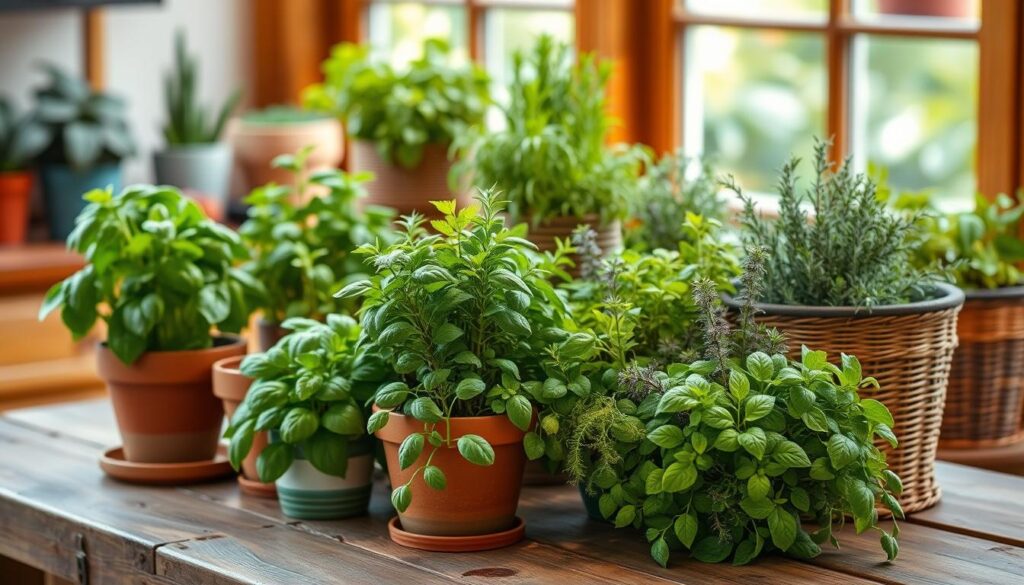
To cultivate a thriving herb garden, you’ll need the right tools and supplies. Whether you’re growing your herbs indoors or outdoors, having the appropriate equipment is crucial for their health and productivity.
Containers and Planters
The first step in creating your herb garden is selecting the right containers. Choose planters that are well-draining and have enough room for your herbs’ roots to grow. Consider using recycled materials like old pots or wooden planters to add a personal touch.
Soil and Fertilizers
Using the right soil and fertilizers is vital for herb plant care. Opt for a high-quality potting mix that’s designed for indoor plants if you’re growing your herbs inside. For outdoor gardens, mix in some organic fertilizer to promote healthy growth.
Watering Equipment
Watering is a critical aspect of maintaining your herb garden. Invest in a good watering can or a drip irrigation system to ensure your plants receive the right amount of moisture without wasting water.
Basic Gardening Tools
Some basic gardening tools are essential for maintaining your herb garden. These include a trowel for planting, pruning shears for trimming, and a cultivator for aerating the soil.
Indoor vs. Outdoor Herb Gardens: Which Is Right for You?
When it comes to growing herbs, one of the most important decisions you’ll make is whether to cultivate your garden indoors or outdoors. Both options have their advantages and disadvantages, which we’ll explore in this section to help you decide what’s best for your indoor herb gardening needs.
Advantages of Indoor Herb Gardens
Indoor herb gardens offer several benefits, including year-round access to fresh herbs and protection from pests and extreme weather conditions. With indoor gardens, you can control the environment, ensuring optimal growing conditions for your herbs. This is particularly beneficial for popular kitchen herbs that are sensitive to frost or require consistent warmth.
Benefits of Outdoor Herb Gardens
Outdoor herb gardens, on the other hand, provide natural sunlight and space for your herbs to grow. Outdoor gardens can be more spacious, allowing for a greater variety of herbs and a more diverse ecosystem. Many herbs thrive in outdoor conditions, where they can receive full sun and air circulation, promoting healthy growth.
Seasonal Considerations
Seasonal changes can significantly impact your herb garden, whether it’s indoors or outdoors. Indoor gardens are generally less affected by seasonal changes, as they are shielded from extreme temperatures and weather conditions. Outdoor gardens, however, require more maintenance during seasonal transitions, such as protecting herbs from frost in winter or providing shade during the hot summer months.
Space Requirements
The space available for your herb garden is another critical factor to consider. Indoor gardens can be adapted to small spaces, such as windowsills or countertops, making them ideal for urban dwellers or those with limited space. Outdoor gardens, while potentially larger, require a suitable plot of land with adequate sunlight and drainage.
Kitchen Herbs You Can Grow & Use in Cooking
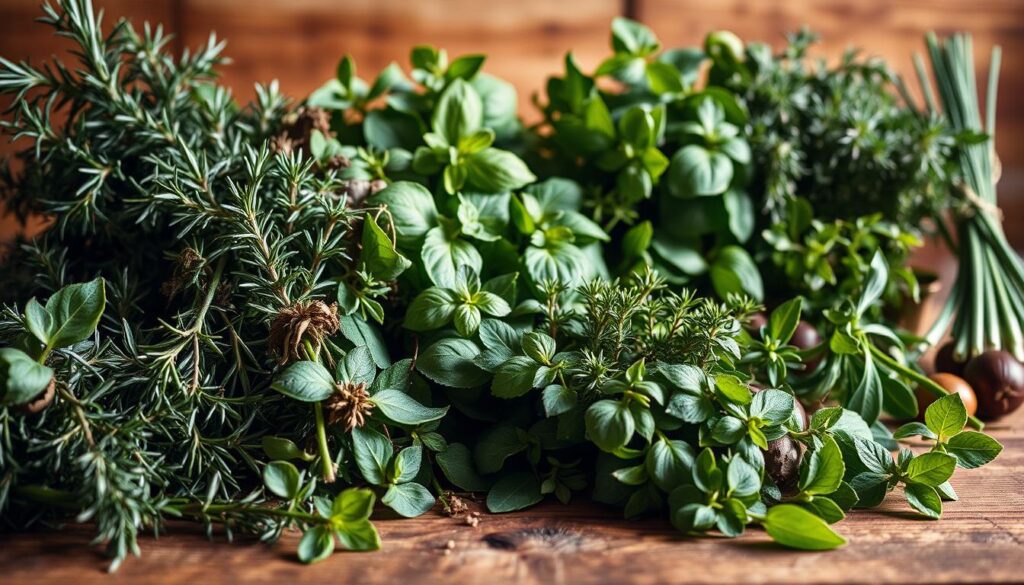
Whether you’re a seasoned chef or a beginner in the kitchen, growing your own herbs can be a rewarding experience. Not only do they add flavor to your dishes, but they also provide a sense of accomplishment and connection to your food.
Annual vs. Perennial Herbs
When starting your herb garden, it’s essential to understand the difference between annual and perennial herbs. Annual herbs, like basil and cilantro, complete their life cycle within a year and need to be replanted. Perennial herbs, such as rosemary and thyme, come back year after year, providing a consistent supply with less maintenance.
Easy Herbs for Beginners
For those new to herb gardening, starting with easy-to-grow herbs is a great way to build confidence. Herbs like mint, parsley, and chives are hardy and require minimal care, making them perfect for beginners.
More Challenging but Rewarding Herbs
Once you’ve gained some experience, you might want to try growing more challenging herbs like lemongrass or tarragon. These herbs require more specific conditions but offer unique flavors that can elevate your cooking.
Herb Combinations for Different Cuisines
Different cuisines often rely on specific herb combinations. For example, Italian cooking frequently uses basil, oregano, and rosemary, while Mexican cuisine often incorporates cilantro, epazote, and Mexican oregano. Experimenting with these combinations can help you discover new flavors.
| Cuisine | Herb Combinations |
|---|---|
| Italian | Basil, Oregano, Rosemary |
| Mexican | Cilantro, Epazote, Mexican Oregano |
| French | Thyme, Lavender, Tarragon |
By understanding the types of herbs and their uses in different cuisines, you can enhance your cooking with fresh, home-grown flavors. Whether you’re cooking with fresh herbs or drying them for later use, the possibilities are endless.
Basil: The King of Kitchen Herbs
Basil is often hailed as the king of kitchen herbs, and for good reason. Its sweet and aromatic flavor makes it a staple in many cuisines, particularly in Mediterranean and Asian cooking.
Growing and Caring for Basil
To grow basil successfully, it needs well-drained soil and plenty of sunlight. It’s a warm-season crop that thrives in temperatures between 65°F and 85°F. Regular watering is essential, but be cautious not to overwater, as this can lead to root rot.
Harvesting Basil Properly
Harvesting basil regularly encourages the plant to produce more leaves. Pinch off flower buds as they form to direct the plant’s energy towards leaf production. Use scissors to cut off the top sets of leaves, just above a node, to promote bushy growth.
Culinary Uses and Recipes
Basil is incredibly versatile in the kitchen. It’s a key ingredient in many classic dishes, from pesto to caprese salads.
Mediterranean Dishes
In Mediterranean cuisine, basil is often paired with tomatoes, mozzarella, and olive oil. Try adding fresh basil to your next bruschetta or Greek salad for an extra burst of flavor.
In Asian cooking, basil is used in stir-fries, curries, and as a fresh garnish. It pairs well with ingredients like lemongrass and chilies. Add Thai basil to your next stir-fry for a fragrant and spicy kick.
Whether you’re making a traditional Italian sauce or an aromatic Thai curry, basil is sure to elevate your dish. Experiment with different varieties of basil to discover new flavors and aromas in your cooking.
Mint, Rosemary, and Thyme: Versatile Perennial Herbs
In the world of culinary herbs, mint, rosemary, and thyme stand out as versatile perennials that can be used in a multitude of recipes. These hardy herbs not only add flavor to various dishes but also offer numerous health benefits and fragrance. Let’s explore how to grow them and make the most of their culinary potential.
Growing These Hardy Perennials
Growing mint, rosemary, and thyme requires some basic knowledge of their preferences. Mint thrives in moist soil and partial shade, while rosemary and thyme prefer well-drained soil and full sun. We recommend planting them in areas that receive adequate sunlight and have good air circulation to prevent diseases.
Controlling Mint's Spreading Habit
Mint is known for its aggressive spreading habit, which can be both a blessing and a curse. To control its spread, we suggest planting mint in containers or using barriers to restrict its roots. Regular pruning also helps keep mint under control and encourages bushy growth.
Culinary Applications
Mint, rosemary, and thyme are incredibly versatile in the kitchen. They can be used in a variety of dishes, from desserts and beverages to savory meals.
Desserts and Beverages
Mint is a classic addition to desserts like ice cream and chocolate mousse, as well as refreshing beverages such as mojitos and mint tea. Thyme can be used in sweet dishes like thyme-infused honey, while rosemary pairs well with lemon in desserts and drinks.
Savory Dishes
Rosemary and thyme are staples in savory cooking, complementing roasted meats, stews, and soups. Mint adds a cool flavor to salads, yogurt sauces, and Middle Eastern dishes like tabbouleh. We often use these herbs to add depth and complexity to our cooking.
Parsley, Cilantro, and Dill: Essential Leafy Herbs
For those looking to add some freshness to their cooking, parsley, cilantro, and dill are essential herbs to grow. These leafy herbs are staples in many cuisines and can elevate a variety of dishes with their unique flavors.
Growing These Short-Lived Herbs
Parsley, cilantro, and dill are considered short-lived because they have relatively short lifespans compared to perennial herbs. Cilantro, for example, bolts quickly, so it’s essential to plant it in succession to have a continuous supply. Parsley and dill also benefit from successive planting to ensure a steady harvest.
Succession Planting Techniques
Succession planting involves planting small batches of seeds every few weeks. This technique ensures that you have a continuous supply of fresh herbs. For cilantro, which has a particularly short lifespan, planting every two weeks is recommended.
Using Fresh vs. Dried
While these herbs can be used both fresh and dried, their flavors are more vibrant when used fresh. “Fresh herbs add a brightness and depth to dishes that dried herbs can’t match,” says a renowned chef. However, drying or freezing can be a good way to preserve them for later use.
Recipe Ideas
These herbs can be used in a variety of dishes. Parsley is great in salads or as a garnish, cilantro adds flavor to salsas and Mexican dishes, and dill is perfect for pickling or in Scandinavian cuisine. Try adding them to your favorite recipes for an extra burst of flavor.
By incorporating parsley, cilantro, and dill into your cooking, you can add freshness and depth to your dishes. Whether you’re a seasoned chef or a beginner in the kitchen, these leafy herbs are sure to become staples in your culinary repertoire.
Harvesting and Preserving Your Herb Bounty
Harvesting and preserving herbs is a crucial step in making the most of your garden’s yield throughout the year. By following the right techniques, we can enjoy our homegrown herbs even when they’re out of season.
When and How to Harvest
The key to successful herb harvesting is timing. Most herbs are best harvested in the morning, after the dew has dried but before the heat of the day. We should pinch or cut off the leaves or stems as needed, making sure to leave enough for the plant to continue growing.
Drying Herbs
Drying is one of the simplest ways to preserve herbs. We can tie the herbs in small bunches and hang them upside down in a warm, dry place. Alternatively, we can use a food dehydrator on a low setting. Proper drying helps retain the herbs’ flavor and aroma.
Freezing Methods
Freezing is another effective method for preserving herbs. We can chop the herbs finely and place them in ice cube trays, covering them with water or olive oil before freezing. This way, we can enjoy our herbs throughout the year by simply dropping the frozen cubes into our recipes.
Making Herb Oils and Vinegars
Infusing oils and vinegars with herbs is a great way to capture their flavor. We fill a clean glass jar with fresh herbs and cover them with oil or vinegar. After a few weeks, the liquid will have taken on the flavor and aroma of the herbs, making it perfect for dressings and marinades.
By applying these herb preservation techniques, we can savor the taste of our garden’s bounty all year round.
Troubleshooting Common Herb Garden Problems
Troubleshooting is an essential part of herb gardening, helping us identify and solve problems before they become severe. By understanding common issues, we can take proactive steps to maintain a healthy and thriving herb garden.
Pest Management
Pests can be a significant problem in herb gardens, damaging plants and reducing yields. Common pests include aphids, spider mites, and slugs. To manage pests effectively, use organic methods whenever possible, such as introducing beneficial insects or spraying with neem oil.
Disease Prevention and Treatment
Diseases can also affect herb gardens, often caused by fungal or bacterial infections. To prevent disease, ensure good air circulation around plants and avoid overhead watering. If disease occurs, remove affected plants or parts to prevent the spread.
Nutrient Deficiencies
Nutrient deficiencies can impact herb plant health, leading to symptoms like yellowing leaves or stunted growth. Regular soil testing can help identify deficiencies, allowing for targeted fertilization.
Watering Issues
Watering issues, whether overwatering or underwatering, can stress herb plants. Check soil moisture regularly and adjust watering schedules according to weather conditions to maintain optimal moisture levels.
Conclusion: Enjoying the Fruits of Your Herb Garden
As we conclude our journey through the world of kitchen herbs, we’re excited to encourage you to start your own herb garden. Growing your own kitchen herbs you can grow & use in cooking can be a rewarding experience, providing you with fresh flavors and aromas to enhance your cooking.
With a little care and attention, your herb garden will thrive, allowing you to enjoy the benefits of cooking with fresh herbs. Whether you’re a seasoned gardener or just starting out, the joys of harvesting and using your homegrown herbs are undeniable.
As you explore the world of kitchen herbs, we hope you’ll discover new flavors and recipes to enjoy. By incorporating fresh herbs into your cooking, you’ll not only elevate your dishes but also experience the satisfaction of nurturing your own herb garden.
FAQ
What are the best kitchen herbs to grow for cooking?
We recommend starting with popular and versatile herbs like basil, mint, rosemary, thyme, parsley, cilantro, and dill. These herbs are easy to grow and can be used in a variety of dishes, from Mediterranean and Asian-inspired recipes to salads and sauces.
How do I care for my indoor herb garden?
To keep your indoor herb garden thriving, make sure to provide adequate light, water, and nutrients. Most herbs require at least 4-6 hours of direct sunlight per day, and should be watered when the top inch of soil feels dry. We also recommend fertilizing your herbs regularly to promote healthy growth.
Can I grow herbs year-round indoors?
Yes, with the right conditions, you can grow herbs indoors year-round. Most herbs require a consistent temperature between 65-75°F (18-24°C), and some may need additional lighting during the winter months. By controlling the environment, you can enjoy fresh herbs 365 days a year.
How often should I harvest my herbs?
The frequency of harvesting depends on the type of herb and its growth rate. For example, basil and mint can be harvested regularly to encourage new growth, while rosemary and thyme can be harvested as needed. We recommend checking your herbs regularly and harvesting them when they are at their peak flavor and aroma.
What are some common pests that can affect herb gardens, and how can I manage them?
Common pests that can affect herb gardens include aphids, spider mites, and mealybugs. To manage these pests, we recommend using organic pest control methods like neem oil, insecticidal soap, and diatomaceous earth. Regularly inspecting your plants and removing any infested or damaged leaves can also help prevent pest issues.
Can I use dried herbs instead of fresh ones in cooking?
While dried herbs can be a convenient substitute for fresh herbs, they have a different flavor profile and texture. We recommend using fresh herbs whenever possible, but dried herbs can be a good alternative when fresh herbs are not available. Simply adjust the amount used according to the recipe and your personal taste.


